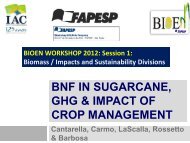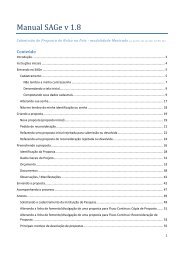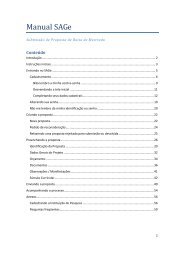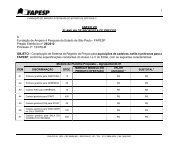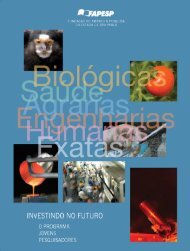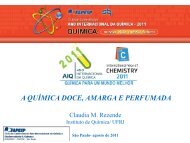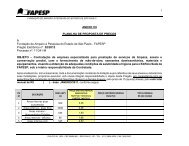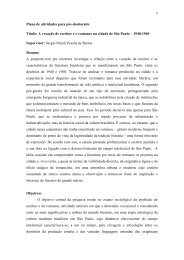Chromosome - Fapesp
Chromosome - Fapesp
Chromosome - Fapesp
You also want an ePaper? Increase the reach of your titles
YUMPU automatically turns print PDFs into web optimized ePapers that Google loves.
BioEnergy Workshop,<br />
May 2012, São Paulo, Brazil<br />
COSMIC: Clostridium acetobutylicum Systems Microbiology<br />
Systems and Synthetic Biology<br />
approaches to fuel and chemical<br />
commodity production through sugar and<br />
gas fermentation<br />
Nigel P Minton<br />
Clostridia Research Group
Professor Yang<br />
Fujia<br />
Chancellor 2001-<br />
總統<br />
• Founded 1798<br />
• 5 Faculties<br />
• 36,000 students,<br />
• 5 th largest in UK<br />
• 6,000 staff, 2,000<br />
academic staff<br />
• 4 UK campuses<br />
• 2 international campuses<br />
• 28 spinout companies<br />
The University<br />
綜合性大學<br />
5系<br />
36 000名學生,<br />
6000名工作人員,<br />
2000名教師<br />
4英國校園<br />
2個國際校園<br />
28分拆公司<br />
Professor David<br />
Greenaway<br />
Vice-Chancellor<br />
2008-<br />
行政長官
University of Nottingham<br />
UK Campus (1928)<br />
36,000 students<br />
University of Nottingham<br />
Malaysia Campus (2003)<br />
3,700 students<br />
University of Nottingham<br />
Ningbo Campus (2006)<br />
4,300 students<br />
The Location<br />
Birmingham<br />
Edinburgh<br />
Nottingham<br />
LONDON
The Location<br />
Birmingham<br />
Edinburgh<br />
Nottingham<br />
LONDON
Multidisciplinary Centre<br />
Centre for Biomolecular Sciences (CBS)<br />
CBS houses over 300 scientists in an environment<br />
that promotes core science and interdisciplinary<br />
research. A total of £40 million has been invested<br />
to create an excellent blend of chemistry,<br />
biology and engineering laboratories.
Clostridia Research Group<br />
HEAD<br />
Professor Nigel P Minton<br />
DEPUTY<br />
Dr Klaus Winzer<br />
Associated School<br />
Members<br />
Dr Alan Cockayne<br />
Dr Kim Hardie<br />
Centre for Biomolecular Sciences (CBS)<br />
CBS houses over 300 scientists in an environment<br />
that promotes core science and interdisciplinary<br />
research. A total of £40 million has been invested<br />
to create an excellent blend of chemistry,<br />
biology and engineering laboratories.
Clostridia Research Group<br />
HEAD<br />
Professor Nigel P Minton<br />
DEPUTY<br />
Dr Klaus Winzer<br />
Associated School<br />
Members<br />
Dr Alan Cockayne<br />
Dr Kim Hardie<br />
MEDICALLY IMPORTANT CLOSTRIDIA<br />
Research Fellows<br />
Dr Sarah Kühne (MRC)<br />
Dr Stephen Cartman (MRC)<br />
Dr Mark Collery (UoN)<br />
Dr Sheryl Philip (UoN)<br />
Vacancy (UoN)<br />
Vacancy (BRU)<br />
Technical<br />
Ms Michelle Kelly (UoN)<br />
Vacancy (UoN)<br />
PhD<br />
Magda Fit (BBSRC)<br />
Tom Bailey (BBSRC CASE)<br />
Aleksandra Kubiak (ZonMw)<br />
Nimit Joshi (MRC/UoN)<br />
Christopher Humphreys (BBSRC CASE)<br />
Daniella Heeg (EU Marie Curie)<br />
Nial Bollard (EU Marie Curie)<br />
Carlo Rotta (EU Marie Curie)<br />
Carolyn Meaney (EU Marie Curie)<br />
Jorge Mauricio Montfort (Self)<br />
Tom Layland (BBSRC)<br />
Patrick Budd (White Healthcare)<br />
Vacancy (MRC)<br />
Vacancy (BRU)<br />
Vacancy (BRU)<br />
Vacancy (BRU)<br />
NON-MEDICAL CLOSTRIDIA<br />
Research Fellows<br />
Dr Wouter Kuit (BBSRC BioEnergy)<br />
Dr Elisabeth Steiner (Industry)<br />
Dr Katalin Kovacs(BBSRC BioEnergy)<br />
Dr Katrin Schwartz (BBSRC BioEnergy)<br />
Dr Ying Zhang (BBSRC SysMO)<br />
Anne Henstra (UoN)<br />
Vacancy (Industry)<br />
Vacancy (UoN)<br />
Technical<br />
Vacancy (UoN)<br />
Vacancy (Industry)<br />
Vacancy (Industry)<br />
PhD<br />
Gareth Little (UoN/TMO)<br />
Muhammad Eshaan (UoN/TMO)<br />
Hengzheng Wang (UoN BioEnergy)<br />
Ben Willson(UoN BioEnergy)<br />
Sarah Mastrangelo (BBSRC DTA)<br />
Lili Sheng (BBSRC CASE)<br />
Anne-Katrin Kottë – (EU Marie Curie)<br />
Eric Liew (Industry)<br />
ADMINISTRATIVE<br />
Jacque Minton (EU)
STRENGTHS<br />
The Remit of the CRG<br />
5/28/2012 8<br />
• Biological Engineering<br />
� Systems and Synthetic Biology<br />
� Underpinned by Advanced Gene Tools (gene technologies are the<br />
largest portfolio of Material Transfer Agreements at Nottingham)<br />
Biobutanol (Clostridium & Geobacillus)<br />
Chemicals from Gas (CO & H2)
http://www.bsbec.bbsrc.ac.uk<br />
Key facts<br />
Duncan Eggar – January 2010<br />
• Inaugurated in January 2009<br />
• Largest ever single investment by the BBSRC<br />
• A virtual centre with six research programmes<br />
• Focus on biochemical routes to gasoline<br />
substitutes<br />
• Focus is Second Generation Biofuels
Perennial<br />
Bioenergy<br />
Crops<br />
Angela Karp<br />
(Rothamsted)<br />
• IBERS<br />
• Imperial<br />
College<br />
• University of<br />
Cambridge<br />
• Ceres Inc<br />
BSBEC UK Bioenergy Centre<br />
Cell Wall Lignin<br />
Claire Halpin<br />
(Dundee)<br />
• University of York<br />
• SCRI<br />
• RERAD<br />
• Limagrain UK Ltd<br />
• Syngenta<br />
• AgroParisTec –<br />
INRA joint Research<br />
Unit of Biological<br />
Chemistry<br />
Cell Wall Sugars<br />
Paul Dupree<br />
(Cambridge)<br />
• Newcastle University<br />
• Novozymes A/G<br />
Marine<br />
Wood Borer Enzyme<br />
Discovery<br />
Simon McQueen-Mason<br />
(York)<br />
• University of Portsmouth<br />
• Syngenta Biomass Traits<br />
Group<br />
Second Generation, Sustainable,<br />
Bacterial Biofuels<br />
Nigel Minton (Nottingham)<br />
• Newcastle University<br />
• TMO Renewables Ltd<br />
Lignocellulosic Conversion to<br />
Bioethanol<br />
Katherine Smart (Nottingham)<br />
• University of Bath • University of Surrey<br />
• BP • Bioethanol Ltd<br />
• Briggs of Burton • British Sugar Ltd<br />
• Coors Brewers Ltd • DSM<br />
• Ethanol Technology Ltd • HGCA<br />
• Pursuit Dynamics • SABMiller<br />
• Scottish Whisky Research Institute<br />
BSBEC Pipeline and the BSBEC People<br />
Fuel<br />
ENVIRONMENTAL, SOCIAL, ECONOMIC SUSTAINABILITY<br />
Duncan Eggar – October 2010
Unlike Yeast<br />
Bacteria Utilise<br />
Pentose Sugars<br />
Clostridia & Biofuels<br />
Lactate<br />
PENTOSES<br />
ATP<br />
NADH<br />
SUGAR<br />
Pyruvate<br />
2 NADH<br />
2 ATP<br />
Fd Ox<br />
Fd Red<br />
Acetate Acetyl-P Acetyl-CoA Acetaldehyde<br />
NADH<br />
HEXOSES<br />
H 2<br />
NADH<br />
Companies<br />
• MASCOMA<br />
• QTEROS<br />
ETHANOL<br />
Clostridium thermocellum<br />
Clostridium phytofermentans
Unlike Yeast<br />
Bacteria Utilise<br />
Pentose Sugars<br />
ACETONE<br />
Clostridia & Biofuels<br />
Acetate<br />
Lactate<br />
PENTOSES<br />
ATP<br />
Acetoacetate<br />
ATP<br />
NADH<br />
Acetyl-P<br />
SUGAR<br />
Pyruvate<br />
Acetyl-CoA Acetaldehyde<br />
Acetoacetyl-CoA<br />
NADH<br />
2 NADH<br />
2 ATP<br />
Fd Ox<br />
Fd Red<br />
NADH<br />
HEXOSES<br />
Butyrate Butyryl-P Butyryl-CoA Butyraldehyde<br />
H 2<br />
NADH NADH<br />
NAD(P)H<br />
Companies<br />
• COBALT<br />
• GBL<br />
• METEX<br />
ETHANOL<br />
Clostridium thermocellum<br />
Clostridium phytofermentans<br />
BUTANOL<br />
Clostridium acetobutylicum
Unlike Yeast<br />
Bacteria Utilise<br />
Pentose Sugars<br />
ACETONE<br />
isoPROPANOL<br />
Clostridia & Biofuels<br />
Acetate<br />
Lactate<br />
PENTOSES<br />
ATP<br />
Acetoacetate<br />
ATP<br />
NADH<br />
Acetyl-P<br />
SUGAR<br />
Pyruvate<br />
Acetyl-CoA Acetaldehyde<br />
Acetoacetyl-CoA<br />
NADH<br />
2 NADH<br />
2 ATP<br />
Fd Ox<br />
Fd Red<br />
NADH<br />
HEXOSES<br />
Butyrate Butyryl-P Butyryl-CoA Butyraldehyde<br />
H 2<br />
NADH NADH<br />
NAD(P)H<br />
Companies<br />
• COBALT<br />
• GBL<br />
• METEX<br />
ETHANOL<br />
Clostridium thermocellum<br />
Clostridium phytofermentans<br />
BUTANOL<br />
Clostridium beijerinckii Clostridium acetobutylicum
ACETONE<br />
isoPROPANOL<br />
Clostridia & Biofuels<br />
Acetate<br />
Lactate<br />
ATP<br />
Acetoacetate<br />
ATP<br />
NADH<br />
Acetyl-P<br />
SUGAR<br />
Pyruvate<br />
Acetyl-CoA Acetaldehyde<br />
Acetoacetyl-CoA<br />
NADH<br />
2 NADH<br />
2 ATP<br />
Fd Ox<br />
Fd Red<br />
NADH<br />
Butyrate Butyryl-P Butyryl-CoA Butyraldehyde<br />
H 2<br />
NADH NADH<br />
NAD(P)H<br />
Companies<br />
• LANZATECH<br />
• COSKATA<br />
CO + H 2<br />
(SynGas)<br />
ETHANOL<br />
Clostridium thermocellum<br />
Clostridium phytofermentans<br />
Clostridium ljungdahlii<br />
BUTANOL<br />
Clostridium beijerinckii Clostridium acetobutylicum
S T<br />
R AI<br />
N<br />
I<br />
M PROVE<br />
M ENT<br />
Clostridia & Biofuels<br />
Butanol is a superior Biofuel to Ethanol<br />
Three major factors * determine the economic competitiveness<br />
of butanol production:<br />
– low product yields versus solvent toxicity<br />
• wasteful production of acetone, ethanol & hydrogen<br />
• relative low resistance to butanol<br />
– substrate costs<br />
• sugar & starch – competition with food<br />
• lignocellulose – solventogenic clostridia not cellulosic<br />
– costs of downstream processing<br />
• distillation expensive at current butanol yields<br />
• gas stripping, pervaporation, adsorption<br />
* Peter Dürre (2006) Annals of the New York Academy of Sciences, 1125: p353 - 362
S T<br />
R AI<br />
N<br />
I<br />
M PROVE<br />
M ENT<br />
Clostridia & Biofuels<br />
Butanol is a superior Biofuel to Ethanol<br />
Three major factors * determine the economic competitiveness<br />
of butanol production:<br />
Pivotal Requirements<br />
– low product yields versus solvent toxicity<br />
• wasteful production of acetone, ethanol & hydrogen<br />
• a need • to relative better lowunderstand resistance to butanol the ‘System’, and;<br />
– substrate costs<br />
• a means to manipulate the System through gene<br />
• sugar & starch – competition with food<br />
modification, inactivation and addition<br />
• lignocellulose – solventogenic clostridia not cellulosic<br />
– costs of downstream processing<br />
• distillation expensive at current butanol yields<br />
• gas stripping, pervaporation, adsorption<br />
* Peter Dürre (2006) Annals of the New York Academy of Sciences, 1125: p353 - 362
ACETONE<br />
Clostridia & Biofuels<br />
Biphasic Metabolism<br />
1 st Phase – produces Acids<br />
2 nd Phase – produces Solvents<br />
Molecular basis of the switch is<br />
UNKNOWN<br />
ATP<br />
Acetate<br />
Acetoacetate<br />
ATP<br />
Acetyl-P<br />
SUGAR<br />
Pyruvate<br />
Acetyl-CoA Acetaldehyde<br />
Acetoacetyl-CoA<br />
NADH<br />
2 NADH<br />
2 ATP<br />
Fd Ox<br />
Fd Red<br />
NADH<br />
Butyrate Butyryl-P Butyryl-CoA Butyraldehyde<br />
H 2<br />
NADH NADH<br />
Acidogenesis<br />
Solventogenesis<br />
NAD(P)H<br />
ETHANOL<br />
BUTANOL<br />
Clostridium acetobutylicum
Clostridia & Biofuels<br />
Peter Dürre (Co-ordinator)<br />
Willem de Vos Servé Kengen<br />
John R. King<br />
Hubert Bahl Ralf-Jörg<br />
Fischer<br />
Klaus Winzer Nigel Minton (Vice Co-ordinator)<br />
Olaf<br />
Wolkenhauer<br />
Thomas<br />
Millat<br />
Armin Ehrenreich Peter Götz
pH<br />
7<br />
6,5<br />
6<br />
5,5<br />
5<br />
4,5<br />
4<br />
3,5<br />
Clostridia & Biofuels<br />
”Dynamic Shift Experiment”<br />
[transcriptome & metabolites analysed at set time points]<br />
Acidogenic phase: pH 5.8<br />
[pH held through addition of 2M<br />
KOH]<br />
pH control removed<br />
‘dynamic shift’<br />
pH 5.8 to 4.5<br />
sporulation vegetative cells<br />
3<br />
0 50 100 150 200 250 300<br />
time(h)<br />
Solventogenic phase: pH 4.5<br />
[pH held through addition of 2M<br />
KOH]
Clostridia & Biofuels<br />
‘Systems Biology’ of Butanol Formation<br />
Blue lines - model predictions<br />
Red dots - data from dynamic shift experiments<br />
Joint metabolic/<br />
gene regulation<br />
network model<br />
Parameters were<br />
estimated in<br />
SBToolbox for<br />
Matlab using several<br />
metabolic data sets<br />
(generated by the<br />
experimentalist<br />
groups)
Clostridia & Biofuels<br />
‘Systems Biology’ of Butanol Formation<br />
Blue lines - model predictions<br />
Red dots - data from dynamic shift experiments<br />
The Modellers<br />
requested a<br />
‘Reverse Shift’<br />
Experiment<br />
The model<br />
demonstrates a<br />
good fit to the data,<br />
providing the means<br />
to investigate the<br />
effects of altering<br />
gene expression<br />
through rDNA<br />
approaches.
Clostridia & Biofuels<br />
‘Systems Biology’ of Butanol Formation<br />
Can the model be<br />
used to develop<br />
experimentallytestable<br />
hypotheses<br />
concerning enhancing<br />
butanol production?<br />
Focus on steady-state studies: at constant pH 4.5 (i.e.<br />
solventogenesis) what is the effect on butanol yield of varying<br />
expression levels of individual genes?
Clostridia & Biofuels<br />
‘Systems Biology’ of Butanol Formation<br />
Prediction:<br />
Targeting a single<br />
gene is insufficient<br />
to increase butanol<br />
production<br />
significantly<br />
A Systems Biology Approach to Investigate the Effect of pH-induced Gene Regulation on<br />
Solvent Production by C. acetobutylicum in Continuous Culture. S. Haus, S. Jabbari, T. Millat,<br />
H. Janssen, R.J. Fischer, H. Bahl, J.R. King, O. Wolkenhauer BMC Systems Biology (2010)
Gene Knock-out<br />
The ClosTron: A rapid, highly effective mutagenesis system<br />
for meatbolic engineering in Clostridia (http://clostron.com)<br />
• Carries a small segment of DNA<br />
encoding a mobile group II intron<br />
• The intron jumps from the plasmid<br />
into the host chromosome causing<br />
gene inactivation<br />
• Through DNA synthesis we control<br />
into which gene the intron inserts<br />
• Concomitant with insertion, host<br />
becomes resistant to erythromycin<br />
• This allows the rapid, selectable<br />
creation of stable mutants<br />
Kuehne SA, Heap JT, Cooksley CM, Cartman ST, Minton NP (2011) ClosTron-Mediated Engineering of<br />
Clostridium. Methods Mol Biol. 765: 389-407
Streamlining the System<br />
http://www.clostron.com<br />
• Free to use webbased<br />
algorithm<br />
removes reliance on<br />
Sigma Aldrich kit<br />
• Retargeted region<br />
synthesised and<br />
cloned into ClosTron<br />
vector by DNA2.0<br />
• Retargeted plasmid<br />
delivered within 10-<br />
14 days<br />
• Integrants (mutants)<br />
isolated within 5-7<br />
days of receipt of<br />
plasmid
Lactate<br />
Clostridia & Biofuels<br />
LDH<br />
ctfA, ctfB<br />
ClosTron Mutational Analysis<br />
adhE, adhE,<br />
adhE, adhE,<br />
− over 300 mutants made in<br />
various clostridial species<br />
− >50 in C. acetobutylicum<br />
(10Xs as many as made<br />
worldwide in last 20 yrs),<br />
including 15 in the central<br />
ABE pathway<br />
− product profiles<br />
determined: transcriptome<br />
studies ongoing (TUM)<br />
− has identified those genes<br />
that cannot be inactivated
Clostridia & Biofuels<br />
Metabolic Engineering: ‘Knock-in’<br />
Metabolic Engineering requires more than just ‘knockout’<br />
of function. Equally important is the facility to<br />
make subtle alterations to existing function or to add<br />
an entirely new function through ‘knock-in’.<br />
Classical Allelic Exchange<br />
– reliant on the existence of Negative selection markers<br />
– two new markers developed: WO/2010/084349 and UK Patent<br />
Application No. 0900280.9<br />
Allele-Coupled Exchange (ACE) Technology<br />
– Heap and Minton (2009) Patent No. WO/2009/101400<br />
– rapid genome insertion of DNA fragments of any size or complexity
Principles:<br />
Clostridia & Biofuels<br />
Allele-Coupled Exchange (ACE)<br />
� Design an allele exchange construct in<br />
which a plasmid-borne allele is ‘coupled’<br />
to a chromosomally located allele creating<br />
a new selectable allele.<br />
� Control the sequence of recombination<br />
events using homology arms of very<br />
different lengths.<br />
� It is NOT reliant on negative selection
dcd<br />
ACE and Insertion at PyrE<br />
Insertion of DNA into Clostridium acetobutylicum genome<br />
CAC0026<br />
catP<br />
pyrE<br />
pyrE’<br />
BioBricks<br />
4 3 2 1<br />
pMTL-JH12 ACE Vector<br />
[ Tm R ]<br />
REP<br />
CAC0028<br />
CAC0028<br />
<strong>Chromosome</strong><br />
[ Tm S FOA S Ura + ]
dcd<br />
ACE and Insertion at PyrE<br />
The ACE vector carries two asymmetric homology arms, LHA and RHA<br />
CAC0026<br />
catP<br />
Left homology<br />
arm (LHA)<br />
pyrE<br />
pyrE’<br />
BioBricks<br />
4 3 2 1<br />
pMTL-JH12 ACE Vector<br />
[ Tm R ]<br />
− the ACE plasmid replicon (REP) is defective<br />
REP<br />
Right homology<br />
arm (RHA)<br />
CAC0028<br />
CAC0028<br />
<strong>Chromosome</strong><br />
[ Tm S FOA S Ura + ]
The long right homology arm (RHA) preferentially (always) directs integration<br />
dcd<br />
ACE and Insertion at PyrE<br />
catP<br />
Left homology<br />
arm (LHA)<br />
pMTL-JH12 ACE Vector<br />
[ Tm R ]<br />
REP<br />
Right homology<br />
arm (RHA)<br />
CAC0026 pyrE<br />
CAC0028<br />
BioBricks<br />
pyrE’ 4 3 2 1<br />
CAC0028<br />
− ACE plasmid replicon (REP) is defective: integrants grow faster on<br />
thiamphenicol<br />
<strong>Chromosome</strong><br />
[ Tm R FOA S Ura + ]<br />
homologous<br />
recombination
The shorter left homology arm (LHA) now directs plasmid excision<br />
dcd<br />
homologous<br />
recombination<br />
ACE and Insertion at PyrE<br />
catP<br />
Left homology<br />
arm (LHA)<br />
CAC0026 pyrE<br />
BioBricks<br />
pyrE’ 4 3 2 1<br />
pMTL-JH12 ACE Vector<br />
[ Tm R ]<br />
REP<br />
Right homology<br />
arm (RHA)<br />
CAC0028<br />
CAC0028<br />
<strong>Chromosome</strong><br />
[ Tm R FOA S Ura + ]
Double crossover selected on the basis of acquisition of resistance to fluoroorotic<br />
acid (FOA) due to pyrE inactivation – cells auxotrophic for uracil (Ura - )<br />
homologous<br />
recombination<br />
ACE and Insertion at PyrE<br />
catP<br />
Left homology<br />
arm (LHA)<br />
dcd CAC0026 pyrE’ 4 3 2 1<br />
pyrE<br />
BioBricks<br />
pMTL-JH12 ACE Vector<br />
[ Tm R ]<br />
REP<br />
Right homology<br />
arm (RHA)<br />
CAC0028<br />
CAC0028<br />
<strong>Chromosome</strong><br />
[ Tm S FOA R Ura - ]
ACE and Insertion at PyrE<br />
dcd CAC0026 pyrE’ 4 3 2 1<br />
The ACE plasmid is rapidly lost<br />
BioBricks<br />
CAC0028<br />
<strong>Chromosome</strong><br />
[ Tm S FOA R Ura - ]
ACE and Insertion at PyrE<br />
More BioBricks can be added in iterative cycles through the use of a sister<br />
ACE vector (that corrects the pyrE mutation) and a new RHA<br />
dcd CAC0026<br />
4 3 2 1<br />
pyrE’ CAC<br />
<strong>Chromosome</strong><br />
[ Tm S FOA R Ura - ]
ACE and Insertion at PyrE<br />
The sister ACE vector carries a ‘corrective’ pyrE allele, a RHA based on the<br />
previously added DNA (BioBrick 4) and a new cargo of BioBricks (5-8)<br />
dcd CAC0026<br />
4 3 2 1<br />
pyrE’ CAC<br />
pyrE<br />
BioBricks<br />
8 7 6 5<br />
pMTL-ME6 ACE Vector<br />
[ Tm R ]<br />
catP REP<br />
4<br />
<strong>Chromosome</strong><br />
[ Tm S FOA R Ura - ]
ACE and Insertion at PyrE<br />
The single crossover integrant is selected as before (Tm R ), and then the double<br />
crossover excision event selected on minimal media lacking uracil (Ura + )<br />
Left homology<br />
arm (LHA)<br />
dcd CAC0026<br />
4 3 2 1<br />
pyrE’ CAC<br />
pyrE<br />
BioBricks<br />
8 7 6 5<br />
pMTL-ME6 ACE Vector<br />
[ Tm R ]<br />
catP REP<br />
Right homology<br />
arm (RHA)<br />
4<br />
<strong>Chromosome</strong><br />
[ Tm R FOA R Ura - ]
ACE and Insertion at PyrE<br />
The ACE plasmid is rapidly lost<br />
Left homology<br />
arm (LHA)<br />
dcd CAC0026 pyrE<br />
3 2 1 CAC<br />
pyrE’<br />
BioBricks<br />
8 7 6 5<br />
4<br />
pMTL-ME6 ACE Vector<br />
[ Tm R ]<br />
catP REP<br />
Right homology<br />
arm (RHA)<br />
4<br />
<strong>Chromosome</strong><br />
[ Tm S FOA S Ura + ]
ACE and Insertion at PyrE<br />
The ACE plasmid is rapidly lost<br />
BioBricks<br />
8 7 6 5<br />
dcd CAC0026 pyrE<br />
3 2 1 CAC<br />
4<br />
<strong>Chromosome</strong><br />
[ Tm S FOA S Ura + ]
ACE and Insertion at PyrE<br />
A third iteration of the method can add further DNA (BioBricks 9-12)<br />
using the ACE vector pMTL-JH12<br />
BioBricks<br />
8 7 6 5<br />
dcd CAC0026 pyrE<br />
3 2 1 CAC<br />
BioBricks<br />
12 11 10 9<br />
dcd CAC0026 pyrE’<br />
CAC<br />
4<br />
BioBricks<br />
BioBricks<br />
8 7 6 5 4 3 2 1<br />
<strong>Chromosome</strong><br />
[ Tm S FOA S Ura + ]<br />
<strong>Chromosome</strong><br />
[ Tm S FOA R Ura - ]
ACE and Insertion at PyrE<br />
A third iteration of the method can add further DNA (BioBricks 9-12)<br />
using the ACE vector pMTL-JH12 – ad infinitum …………..<br />
BioBricks<br />
8 7 6 5<br />
dcd CAC0026 pyrE<br />
3 2 1 CAC<br />
BioBricks<br />
12 11 10 9<br />
dcd CAC0026 pyrE’<br />
CAC<br />
4<br />
BioBricks<br />
Etc, Etc ……………..<br />
BioBricks<br />
8 7 6 5 4 3 2 1<br />
<strong>Chromosome</strong><br />
[ Tm S FOA S Ura + ]<br />
<strong>Chromosome</strong><br />
[ Tm S FOA R Ura - ]<br />
<strong>Chromosome</strong><br />
[ Tm S FOA S Ura + ]
ACE Exemplification<br />
Iterative Exemplification of ACE: insertion of the entire<br />
lambda genome into the clostridial genome in 3 iterative cycles<br />
Success Confirmed by:-<br />
• Southern Blot<br />
• Nucleotide Sequencing<br />
An unprecedented<br />
achievement unmatched<br />
by any other group<br />
Heap et al (2012) Nucleic<br />
Acids Research. 2012 Jan<br />
18.
ACE & Metabolic Engineering<br />
C. acetobutylicum ATCC 824<br />
acetate<br />
acetone<br />
butyrate<br />
acetyl-CoA<br />
butyryl-CoA<br />
ethanol<br />
butanol<br />
John Heap
C. beijerinckii B593 makes isopropanol via a primarysecondary<br />
alcohol dehydrogenase, adh<br />
a strain of C. acetobutylicum producing isopropanol (a<br />
fuel) instead of acetone (not a fuel) would be useful<br />
isopropanol<br />
ACE & Metabolic Engineering<br />
acetate<br />
acetone<br />
butyrate<br />
acetyl-CoA<br />
butyryl-CoA<br />
ethanol<br />
butanol
Removal of Co-products?<br />
� C. acetobutylicum ATCC 824 Acetone<br />
Isopropanol<br />
Ethanol<br />
pSOL1<br />
acetate<br />
acetone<br />
butyrate<br />
pSOL1 Megaplasmid carries<br />
the key genes responsible<br />
for solvent production<br />
acetyl-CoA<br />
butyryl-CoA<br />
ethanol<br />
butanol<br />
Butanol<br />
Acetate<br />
Butyrate
Removal of Co-products?<br />
� C. acetobutylicum ATCC 824<br />
� pSOL1 cured using ACE<br />
acetate<br />
butyrate<br />
acetyl-CoA<br />
butyryl-CoA<br />
Acetone<br />
Isopropanol<br />
Ethanol<br />
Butanol<br />
Acetate<br />
Butyrate
Removal of Co-products?<br />
� C. acetobutylicum ATCC 824<br />
� pSOL1 cured using ACE<br />
� ‘blank canvas’ strain created<br />
acetate<br />
butyrate<br />
acetyl-CoA<br />
butyryl-CoA<br />
ethanol<br />
Acetone<br />
Isopropanol<br />
Ethanol<br />
Butanol<br />
Acetate<br />
Butyrate
isopropanol<br />
Removal of Co-products?<br />
� C. acetobutylicum ATCC 824<br />
� pSOL1 cured using ACE<br />
� ‘blank canvas’ strain created<br />
acetate<br />
acetone<br />
Required<br />
for<br />
isopropanol<br />
butyrate<br />
acetyl-CoA<br />
butyryl-CoA<br />
ethanol<br />
Acetone<br />
Isopropanol<br />
Ethanol<br />
Butanol<br />
Acetate<br />
Butyrate
BB-2 prefix BB-2 suffix<br />
GAATTCGCGGCCGCACTAGTPart sequence GCTAGCGCGGCCGCTGCAG<br />
EcoRI<br />
BioBrick-2 Assembly<br />
SpeI<br />
NheI<br />
• we use the BioBrick-2 standard (BB-2) in our work<br />
� ‘Parts’ are constructed in the standard form shown.<br />
� assembly is easy and standardised – the cloning<br />
strategy is always the same<br />
PstI<br />
� any combination can be easily assembled<br />
� ‘Parts’ can be re-used in different strategies
BB-2 prefix BB-2 suffix<br />
GAATTCGCGGCCGCACTAGT Part 1 GCTAGC<br />
EcoRI<br />
BioBrick-2 BioBrick-2 Standard Assembly<br />
Assembly<br />
SpeI<br />
NheI<br />
BB-2 prefix BB-2 suffix<br />
ACTAGT Part 2 GCTAGCGCGGCCGCTGCAG<br />
SpeI<br />
NheI<br />
PstI
BB-2 prefix BB-2 scar BB-2 suffix<br />
Part 1<br />
GAATTCGCGGCCGCACTAGT ACTAGC<br />
GCTAGCGCGGCCGCTGCAG<br />
EcoRI<br />
BioBrick-2 Assembly<br />
SpeI<br />
Part 2<br />
NheI<br />
PstI
BioBrick-2 Assembly<br />
P 1 S<br />
P 2 S<br />
P 1 2 S P 3 S P 4 S<br />
P 1 2 3 4 S<br />
P 3 4 S
RBS<br />
ORF<br />
RBS<br />
ORF<br />
BioBrick-2 Assembly<br />
STOP<br />
BB-2 assembly<br />
RBS<br />
ORF<br />
RBS<br />
ORF<br />
BB-2 assembly<br />
6His+STOP<br />
RBS<br />
ORF<br />
RBS<br />
ORF<br />
BB-2 assembly<br />
Tags allow monitoring of expression independently of strain<br />
performance, which is useful in metabolic engineering.<br />
We generally use FLAG Tags<br />
FLAG+STOP
RBS<br />
RBS<br />
ctfA<br />
ctfB<br />
RBS<br />
RBS<br />
BioBrick-2 Assembly<br />
ctfA<br />
ctfB<br />
BB-2 assembly<br />
BB-2 assembly<br />
FLAG+STOP<br />
FLAG+STOP<br />
RBS<br />
RBS<br />
adc<br />
adh<br />
RBS<br />
RBS<br />
adc<br />
adh<br />
BB-2 assembly<br />
BB-2 assembly<br />
FLAG+STOP<br />
FLAG+STOP
RBS<br />
RBS<br />
BioBrick-2 Assembly<br />
ctfA<br />
ctfA<br />
RBS<br />
ctfA<br />
RBS<br />
ctfB<br />
RBS<br />
adh<br />
RBS<br />
adc<br />
BB-2 assembly BB-2 assembly<br />
RBS<br />
ctfB<br />
RBS<br />
ctfB<br />
RBS<br />
BB-2 assembly<br />
RBS<br />
FLAG-tagged isopropanol Operon<br />
adh<br />
adh<br />
RBS<br />
RBS<br />
adc<br />
adc
ACE & Metabolic Engineering<br />
Adding isopropanol pathway to pSOL1-minus<br />
Western-Blot analysis of lysate, 2x YTG,<br />
12 µg<br />
200 kDa<br />
130 kDa<br />
95 kDa<br />
70 kDa<br />
55 kDa<br />
45 kDa<br />
35 kDa<br />
25 kDa<br />
24 kDa<br />
Katrin Schwarz<br />
+ P- P26 P27 P28 P17 P18 P15 P19 P24 P25
ACE & Metabolic Engineering<br />
Product profiles after 72 h<br />
WT P-<br />
P28 P24 P25<br />
Acetone<br />
Isopropanol<br />
Ethanol<br />
Butanol<br />
Acetoin<br />
Acetate<br />
Butyrate
ACE & Cellulosic Butanol<br />
C. thermocellum<br />
Cellulosome<br />
C. acetobutylicum<br />
Cellulosic clostridia make ethanol, not<br />
butanol<br />
They produce a ‘Cellulosome’:- a<br />
molecular nanomachine – very efficient<br />
in degrading lignocellulose<br />
The core of the complex is a modular,<br />
non-catalytic scaffoldin protein which<br />
serves to bring enzymes into close<br />
proximity via cohesin-dockerin<br />
interactions, enhance enzyme activity<br />
We seek to introduce a functional<br />
cellulosome into the genome of a noncellulolytic<br />
butanol producer using<br />
ACE technology
ACE & Cellulosic Butanol<br />
Cellulosome Scaffold Assembly<br />
• As proof of principle we tested the expression of a native hydrolase<br />
Cel5A in C. acetobutylicum in the presence and absence of the<br />
scaffoldin subunit<br />
• 1 st minicellulosome integrated into the genome of C. acetobutylicum<br />
• Functional benefit currently being tested
Clostridia & Biofuels<br />
STATUS<br />
• We have developed all of the platform technologies<br />
needed to establish Clostridium as a chassis for the<br />
production of chemical commodities and biofuels from<br />
renewables (lignocellulose and waste gas), including:-<br />
– Directed Gene Knock-out systems (inc. in-frame deletions*)<br />
– Random (transposon mariner)*<br />
– Allele-Coupled Exchange Technology (ACE)<br />
– Expression Systems (orthogonal and inducible*)<br />
• Systems working in many species, ie., C. beijerinckii,<br />
C. acetobutylicum, C. ljungdahlii & Geobacillus<br />
• In future our emphasis will switch to acetogenic<br />
bacteria, ie., C. ljungdahlii<br />
* not described due to lack of time
Systems Biology<br />
of BioButanol<br />
Germany, NL<br />
International Collaboration<br />
EUROPE (Germany, Italy, France, Finland, Slovenia)<br />
Clostridia ITN<br />
Germany France,<br />
Finland Slovenia Italy<br />
ASIA (China, Vietnam, India)<br />
Improving Biobutanol Production<br />
China Partnership Award<br />
Chemicals from Renewables<br />
India Partnership Award<br />
Chemicals from CO + H 2<br />
Fachagentur Nachwachsende<br />
Rohstoffe e.V (FNR)<br />
Cellulolytic clostridial consortia<br />
Student Exchange Programme:<br />
Rice Straw Conversion to Biofuels<br />
York/Dundee/IFR/Cardiff/Rothamsted
International Collaboration<br />
OTHER (USA & New Zealand))<br />
Bid to the US DOE with<br />
Jeff Blanchard<br />
(Uni of Massachusetts)<br />
Clostridium phytofermentans<br />
Chemicals from Renewables<br />
Clostridium spp<br />
Chemicals from CO + H 2<br />
Clostridium autoethanogen<br />
Cellulosome Components<br />
Clostridium papyrosolvens
International Collaboration<br />
OTHER (USA & New Zealand))<br />
Bid to the US DOE with<br />
Jeff Blanchard<br />
(Uni of Massachusetts)<br />
BRASIL !!!<br />
Clostridium phytofermentans<br />
Chemicals from Reneables<br />
Clostridium spp<br />
Chemicals from CO + H 2<br />
Clostridium autoethanogen<br />
Cellulosome Components<br />
Clostridium papyrosolvens
Acknowledgements<br />
Clostridia Research Group<br />
5/28/2012<br />
64








